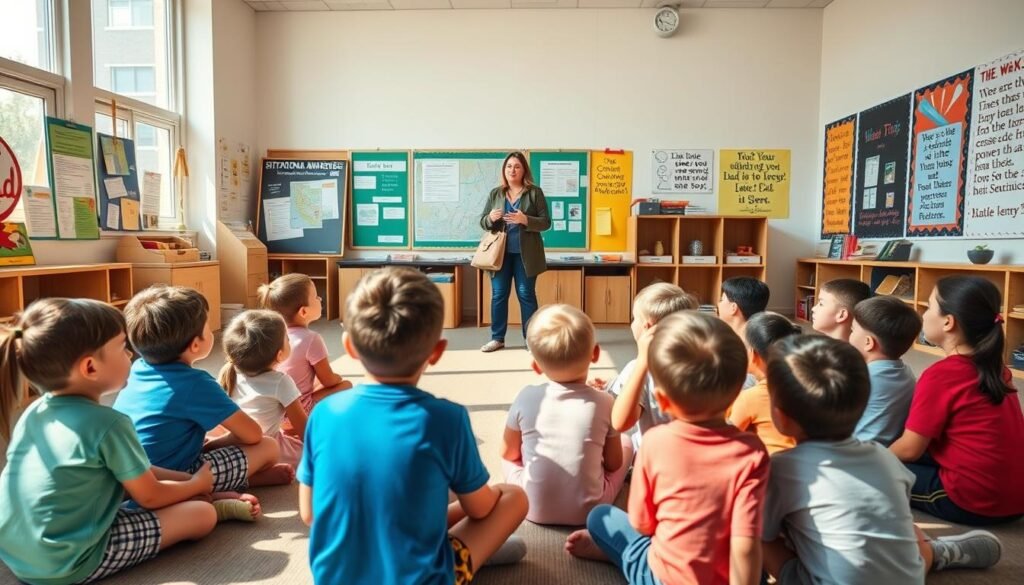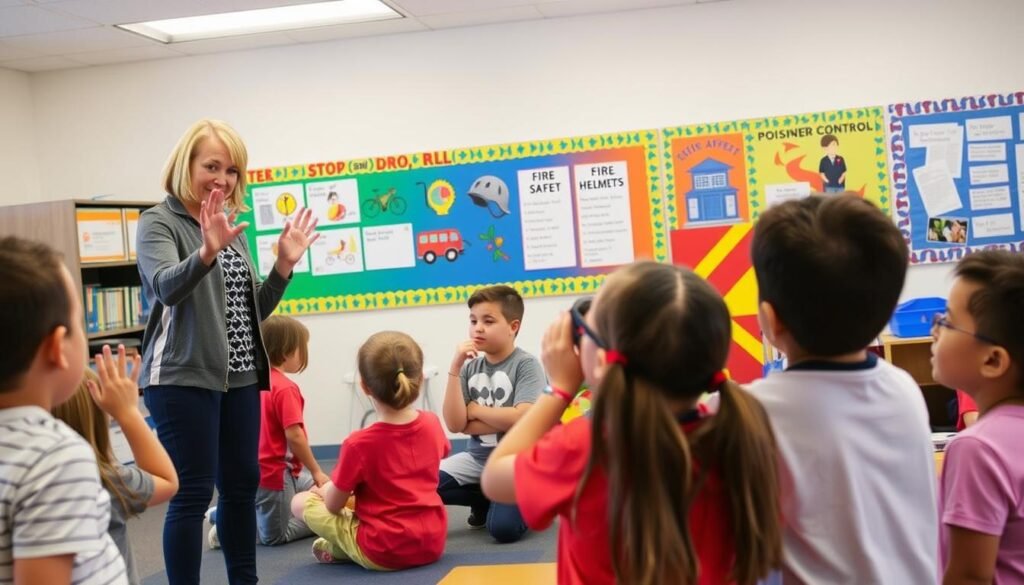Did you know that according to the National Center for Missing & Exploited Children, 1 in 7 children will experience some form of abuse or neglect? Teaching children to be aware of their surroundings and trust their instincts can be a crucial step in keeping them safe.
Instilling situational awareness in kids from a young age can empower them to make better decisions and avoid potentially dangerous situations. This article will explore effective ways to educate children on safety situations, helping parents and caregivers foster a safer environment for their kids.
Key Takeaways
- Understanding the importance of situational awareness for kids
- Effective methods for teaching children about safety
- Strategies for parents to foster a safe environment
- The role of instinct in keeping children safe
- Practical tips for educating kids on situational instincts
Understanding Situational Instincts in Children
Situational instincts play a significant role in how children navigate their environment. These instincts are crucial for their safety and ability to make informed decisions.
What Are Situational Instincts?
Situational instincts refer to the intuitive ability to assess and respond to one’s surroundings. In children, this means being able to recognize potential dangers and take appropriate actions. As stated by child safety experts, “Children’s ability to trust their instincts is a critical component of their overall safety awareness.” Instincts are not just innate; they can be developed and honed over time with practice and guidance.
How Children Naturally Process Their Environment
Children naturally process their environment through a combination of observation, interaction, and instinct. They learn to differentiate between safe and unsafe situations by observing the reactions of adults around them and through personal experiences. This natural processing ability is foundational to developing situational awareness.
The Developmental Timeline of Awareness
The development of situational awareness in children is a gradual process that evolves as they grow.
- Infants begin to develop basic awareness through sensory experiences.
- Toddlers start to understand simple safety rules and boundaries.
- Older children refine their ability to assess complex situations and make decisions based on their understanding of safety.
Understanding this developmental timeline is key to fostering situational awareness in kids.
By recognizing how situational instincts develop and how children process their environment, parents and caregivers can provide targeted guidance to enhance their children’s safety awareness.
Why Educating Kids on Situational Instincts Matters
Situational awareness is a critical life skill that can significantly impact a child’s safety and well-being. In today’s world, where safety concerns are increasingly paramount, educating kids on situational instincts is more crucial than ever.
Safety Benefits in Today’s World
Teaching children to be aware of their surroundings can significantly enhance their safety. By understanding how to assess their environment, kids can better avoid potential dangers. As Dr. Laura Markham, a clinical psychologist, notes, “Children who are taught to be aware of their surroundings are more likely to avoid risky situations.”
“The key to keeping children safe is not to keep them in a bubble, but to teach them how to navigate the world effectively.”
Enhancing children’s situational instincts helps them develop a keen sense of judgment, allowing them to make safer choices. This skill is invaluable in today’s fast-paced and often unpredictable world.
Building Life-Long Decision-Making Skills
Educating kids on situational instincts not only enhances their safety but also contributes to the development of their decision-making skills. By learning to assess situations and make informed decisions, children build a foundation for sound judgment that will benefit them throughout their lives.
As children grow and mature, the ability to make quick and informed decisions becomes increasingly important. Situational awareness teaches kids to weigh their options carefully and choose the safest or most appropriate course of action.
Preventing Potential Dangers
One of the most significant benefits of teaching situational awareness is the potential to prevent dangers before they arise. Children who are adept at reading their environment are less likely to find themselves in harmful situations.
By educating kids on how to trust their instincts and be mindful of their surroundings, we empower them with the tools necessary to avoid potential threats. This proactive approach to safety can make a significant difference in a child’s life.
In conclusion, educating kids on situational instincts is a multifaceted approach that not only enhances their safety but also fosters the development of critical life skills. By incorporating situational awareness into their education, we can help children navigate the complexities of the world around them more effectively.
Age-Appropriate Approaches to Teaching Awareness
Teaching children situational awareness is a vital skill that evolves as they grow. Situational awareness in children is not a one-size-fits-all skill; it requires age-appropriate teaching. As children mature, their ability to understand and respond to their environment changes, necessitating a tailored approach to educating them on safety and awareness.
Preschoolers (Ages 3-5)
For preschoolers, teaching situational awareness begins with simple, engaging methods. Parents can play games that involve identifying safe and unsafe areas, such as recognizing trusted adults and understanding basic safety rules like holding someone’s hand when crossing the street.
- Use simple language to explain safety concepts.
- Practice safety drills, like what to do in case of a fire.
- Encourage them to express their feelings about different situations.
Elementary School Children (Ages 6-10)
As children enter elementary school, they can grasp more complex safety concepts. Role-playing can be an effective tool, allowing them to practice responding to various scenarios, such as encountering a stranger or dealing with bullying.
“The goal is to empower children with the knowledge and confidence to make safe choices.”
Parents can also engage them in discussions about their daily experiences, reinforcing their understanding of situational awareness.
| Age Group | Teaching Methods | Key Concepts |
|---|---|---|
| Preschoolers (3-5) | Simple games, safety drills | Identifying trusted adults, basic safety rules |
| Elementary School (6-10) | Role-playing, discussions | Responding to strangers, dealing with bullying |
| Preteens and Teens (11-17) | Real-life scenario discussions, online safety education | Digital footprint management, emergency protocols |
Preteens and Teens (Ages 11-17)
For preteens and teens, the focus shifts to more advanced situational awareness, including online safety and managing their digital footprint. Discussions about real-life scenarios and the consequences of their choices can be particularly effective.
Encouraging preteens and teens to think critically about their surroundings and the potential risks can help them develop a more nuanced understanding of situational awareness.
Creating a Foundation: Basic Safety Concepts
Establishing a foundation in safety awareness is essential for kids to navigate the world effectively. This foundational knowledge is crucial for their ability to identify and respond to various situations appropriately.
Identifying Safe vs. Unsafe Situations
Teaching children to differentiate between safe and unsafe situations is a critical aspect of developing kids’ safety instincts. Parents can role-play various scenarios with their children, pointing out what makes a situation safe or unsafe. For example, playing near a busy road is considered unsafe, while playing in a designated playground is safe.
Recognizing Trusted Adults
Children need to understand who they can trust in different situations. This involves explaining the concept of trusted adults, such as parents, teachers, or family friends. It’s essential to discuss how to identify trustworthy individuals and how to seek help when needed.
Understanding Personal Boundaries
Understanding personal boundaries is vital for kids to feel safe and respected. Teaching children about their own personal space and the importance of respecting others’ boundaries helps them develop healthy relationships. Simple activities, like role-playing appropriate physical boundaries, can be very effective.
By focusing on these basic safety concepts, parents can significantly enhance their child’s ability to navigate the world safely. It’s about creating a solid foundation upon which more complex safety awareness can be built as they grow.
Practical Exercises to Develop Situational Awareness
Teaching kids to be aware of their surroundings is a vital life skill that can be cultivated through practice. By engaging children in various exercises, parents can help them develop the ability to assess and respond to different situations effectively.
Observation Games for Young Children
Observation games are an engaging way to enhance situational awareness in young children. These games encourage kids to use their senses to observe their environment.
- Identify objects in a room or outside.
- Notice the number of people in a given area.
- Listen for different sounds.
Role-Playing Scenarios
Role-playing is an effective method to teach children how to react in various situations. It helps them understand the consequences of their actions and make informed decisions.
- Practice responding to strangers.
- Learn what to do in case of a fire or other emergencies.
- Understand how to interact with peers and adults in different settings.
Environmental Awareness Activities
Environmental awareness activities help children understand their surroundings and identify potential safety hazards.
Indoor Safety Awareness
Indoor safety awareness involves recognizing potential hazards within the home or building.
- Identify sharp objects or hot surfaces.
- Understand the importance of electrical safety.
Outdoor and Public Space Awareness
Outdoor and public space awareness is crucial for children’s safety when they are outside or in crowded areas.
- Recognize and avoid potential dangers such as traffic or strangers.
- Understand how to stay safe in parks or other public spaces.
| Activity | Age Group | Objective |
|---|---|---|
| Observation Games | 3-5 years | Enhance situational awareness |
| Role-Playing | 6-10 years | Practice decision-making in scenarios |
| Environmental Awareness | 11-17 years | Identify and mitigate safety hazards |
By incorporating these practical exercises into daily life, parents can significantly enhance their children’s situational awareness, equipping them with the skills necessary to navigate various environments safely.
Teaching Kids to Trust Their Instincts
Helping children understand and trust their instincts can significantly impact their ability to navigate various situations. Instincts are innate feelings that can guide children away from potential dangers or uncomfortable situations.
Recognizing Gut Feelings
The first step in teaching kids to trust their instincts is helping them recognize their gut feelings. Gut feelings are those uncomfortable or uneasy sensations they might experience in certain situations or around specific people. Encouraging children to acknowledge and express these feelings is crucial.
For instance, if a child feels uneasy around a particular individual, it’s essential to listen to their concerns without dismissing them. As one expert notes,
“Children’s instincts are often more accurate than we give them credit for.”
Validating Children’s Concerns
Validating children’s concerns is vital in building their trust in their instincts. When children feel that their feelings are acknowledged and taken seriously, they become more confident in their ability to judge situations.
- Listen actively to what they say.
- Avoid dismissing their fears or concerns.
- Offer guidance on how to handle the situation.
Building Confidence in Decision-Making
Building confidence in decision-making goes hand-in-hand with trusting one’s instincts. By allowing children to make age-appropriate decisions and praising their efforts, parents can foster a strong sense of self-trust.
| Age Group | Decision-Making Opportunities |
|---|---|
| Preschoolers (3-5) | Choosing what to wear or what game to play |
| Elementary School Children (6-10) | Deciding on extracurricular activities or simple household chores |
| Preteens and Teens (11-17) | Making choices about their free time or setting personal boundaries |
By following these steps and providing a supportive environment, parents can help their children develop a strong sense of instinct and confidence in their decision-making abilities.

Effective Communication Strategies for Educating Kids on Situational Instincts
Educating children on situational instincts begins with effective communication, laying the groundwork for a lifetime of safety and awareness. Parents and caregivers play a pivotal role in shaping how children perceive and interact with their environment.
Open Dialogue About Safety Without Creating Fear
Maintaining an open dialogue about safety is crucial. It’s about striking a balance between informing children of potential dangers and avoiding the creation of unnecessary fear. This can be achieved by discussing safety topics in a calm and matter-of-fact way, emphasizing that safety is a normal part of life.
Using Teachable Moments in Daily Life
Daily life is filled with teachable moments that can be used to educate children about situational awareness. For example, when walking down a street, parents can point out potential hazards and discuss how to navigate them safely. This approach helps children learn by experience and context.
Responding to Children’s Questions About Safety
When children ask questions about safety, it’s essential to respond in a way that is both reassuring and informative. Parents should validate their concerns, provide clear explanations, and offer guidance on how to handle different situations. This not only helps children feel secure but also builds their confidence in making safe decisions.
By implementing these strategies, parents can effectively communicate with their children about situational awareness, enhancing their ability to navigate the world safely.
Preparing Children for Different Environments
Equipping children with the skills to handle different environments is a key aspect of their kids’ safety education. As they grow, children will encounter various settings that require unique safety awareness and instincts.

School and Classroom Safety
School is a significant environment where children spend a considerable amount of time. Teaching them about classroom safety includes discussing the importance of staying seated during lessons, raising hands to speak, and being aware of emergency exits.
- Identify safe areas in the classroom and school.
- Understand the role of school staff in ensuring safety.
- Practice emergency drills regularly.
Public Places and Crowded Events
Public places and crowded events can be overwhelming for children. It’s crucial to teach them how to stay close to their guardians, identify meeting points in case of separation, and be aware of their surroundings.
- Discuss the importance of staying close to a trusted adult.
- Identify landmarks or meeting points.
- Teach children to avoid talking to strangers.
Online and Digital Environments
In today’s digital age, children are exposed to online environments from an early age. Educating them about online safety includes teaching them about privacy settings, the dangers of sharing personal information, and how to report inappropriate content.
- Use parental controls to monitor online activity.
- Discuss the risks of interacting with strangers online.
- Encourage open dialogue about their online experiences.
Emergency Situation Protocols
Preparing children for emergency situations involves teaching them basic response protocols such as dialing emergency numbers, staying calm, and following instructions from authorities.
- Practice dialing emergency numbers like 911.
- Teach children to stay calm and listen to instructions.
- Discuss the importance of having a family emergency plan.
By educating children on how to navigate these different environments safely, parents can significantly enhance their childhood safety skills and developing kids’ safety instincts.
Conclusion: Empowering Children Through Awareness
Educating kids on situational instincts is a vital life skill that enhances their ability to navigate various environments safely. By teaching kids about safety situations and fostering situational awareness in kids, parents can empower their children to make informed decisions and respond effectively in different scenarios.
As discussed, understanding situational instincts in children is crucial, and age-appropriate approaches can be applied to teach awareness effectively. Creating a foundation of basic safety concepts, practicing observation games, and role-playing scenarios are practical ways to develop situational awareness in kids.
By adopting these strategies, parents can help their children trust their instincts, recognize potential dangers, and develop confidence in decision-making. It’s essential to maintain open dialogue about safety without creating fear, using daily life teachable moments to reinforce these lessons.
Ultimately, empowering children through awareness is a proactive step towards ensuring their safety and well-being. By following the guidelines outlined, parents can play a pivotal role in educating their kids on situational instincts, preparing them for a safer, more aware future.
